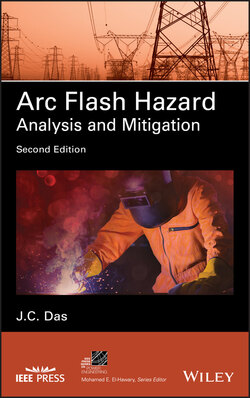Читать книгу Arc Flash Hazard Analysis and Mitigation - J. C. Das - Страница 19
1.2 ARC FLASH HAZARD AND PERSONAL SAFETY
ОглавлениеThe phenomenal progress made by the electrical and electronic industry since Thomas Edison propounded the principle of incandescent lighting in 1897 has sometimes been achieved at the cost of loss of human lives and disabilities. Although reference to electrical safety can be found as early as about 1888, it was only in 1982 that Ralph Lee [11] correlated arc flash and body burns with short-circuit currents. This article is considered by many as pioneering work on arcing phenomena in the open air. It quantified the potential burn hazards. Lee established the curable burn threshold for the human body as 1.2 cal/cm2, which is currently used to define the arc flash boundary. Lee published a second article in 1987, “Pressure Developed from Arcs” [12].
Doughty et al., published two articles [13, 14], and Jones et al. published an article in 2000 [15]. The IEEE 1584 Guide can be considered a breakthrough for arc flash analyses. The previous methods in NFPA 70E were based upon theoretical concepts or drawn from limited testing. The new testing concentrated on arcing faults in a variety of electrical equipment enclosures, arcs in boxes, which is more typical of actual work locations. Yet some researchers are critical of the methodology of the IEEE 1584 Guide; for example, Stokes and Sweeting in “Electrical Arc Burn Hazards” [5], critique Lee’s models and IEEE 1584 Guide equations and testing setup for arc flash burns. Yet the statistics collected on the prevention of arc flash hazard injuries shows that such injuries were prevented when the workers used the required personal protective equipment (PPE) calculated according to the IEEE Guide; see Chapter 3. Wilkins et al. published an article, “Effect of Insulating Barriers in Arc Flash Testing,” in 2008 [16]. The authors used vertical conductors terminated in insulating barriers for their testing methodology. See Chapter 3 for further discussions and observations on these issues.
The OSHA definition of a recordable injury, TRIR, for 1 year of exposure, is as follows:
(1.1)
Most insurance companies accept this parameter of definition because there is a cost associated with these incidents.
